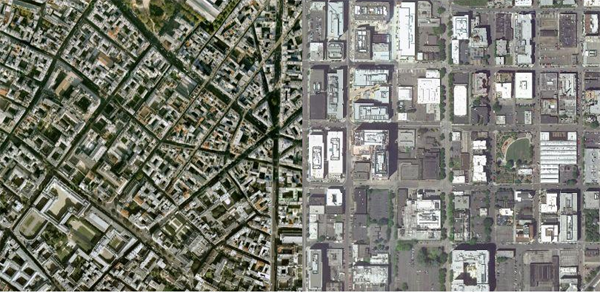Reversing Haussmann: An Exploration of Street Narrowing

< Street in Rome; photo by Mini OzzY via Flickr >
The narrow and winding streets of medieval cities are a huge part of European Romanticism. In contrast, Seattle, like almost all American cities, has relatively wide street right-of-ways. Usually this is simply taken as a fact and we do what we can to mitigate it: vegetated medians, mid-block crossings, curb bulbs, etc. But what if we actually tried to narrow our streets? What if we strategically chose areas to create smaller, more pedestrian friendly pathways? Baron Haussmann secured his place in the urbanist liturgy when he “opened up†Paris by destroying dozens of buildings and replacing them with a network of wide boulevards. Who’s to say we can’t do just the opposite and concentrate the energy of some of our neighborhoods? Risking accusations of “Eurocentric nostalgia†I’d like to flesh out the concept of street narrowing and its implementation in a city like Seattle.
>>>
Small is Beautiful
Certainly the first question to ask is, are narrow streets really a good thing? They have their drawbacks (light exposure, vehicle capacity) but they can also bring some nice benefits.
1.)Â Â Â Human Scale. There is an unbelievable feeling of ease when one wanders the Latin Quarter in Paris or the maze of streets around the Pantheon in Rome. By their very nature, narrow streets are scaled to the human rather than the machine. In fact rather than entities unto themselves, small streets are simply the absence of buildings; they foster a much more cohesive sense of place by removing the vast swaths of dead space that surround the typical American city block. This point is punctuated by the aerial comparison below. Paris (left) is a spread of buildings, with roads interspersed. Seattle (right) is a spread of asphalt with buildings interspersed.
2.)Â Â Â Density. The above comparison also highlights the shear increase in building space that narrow streets afford. In some instances narrowing streets may be a useful alternative to raising heights, a politically hot topic in many of our communities. The Old Urbanist estimates that shrinking streets by 10 feet can increase the buildable area by almost 9%.
3.)Â Â Â Cost Efficiency. In these tough economic times, one cannot overlook the financial benefits that narrow streets provide a municipality. Current streets are essentially a liability; a study in Sacramento put the cost of road maintenance at over $60,000 per mile per year. Narrow streets can help minimize these costs. Further, since this land is transferred to the private sector, it increases the assessed land value in the city. As Roger Valdez has so thoroughly explained this may not directly increase tax revenues but at the very least it can lower the property tax burden on individuals and perhaps increase sales tax revenue.
>>>
The One Block Model
To get a more concrete idea of the benefits of street narrowing, let’s examine a very simplified example. Say we have a single 300-foot long block, and a single 6 six-story building covering the entire area (think Joule on Capitol Hill). Instead of granting the developer another story of height, we decide to shrink the ROW by 10 feet on one side of the building and give that land to the developer. The project area has now increased by 3,000sq ft. or 18,000sq ft over six stories. Here’s what we get:
- 45 additional bedrooms (At 1 bedroom = 400 sq ft. Mines about half that.)
- Or 25 additional housing units (At 1 unit = 700sq ft.)
- $800/yr savings in road maintenance (If street reduced from 40 to 30ft)
- $7.2 million increase in property value (At $400/sq ft unit price)
- $65,088 in property tax revenues (Based on Seattle 2010 property rates)
>>>

< Street in Paris; photo by zoetnet via Flickr >
A Wider View of Narrow Streets
In the model, the benefits are substantial. But of course a comprehensive approach to street narrowing comes with many other challenges. First of all, an actual street narrowing would require much more than a single block. It would need to be a coordinated effort along an entire ROW. Even on a single block there would likely be multiple property owners instead of just one. It should also be said that road diets in this city are probably just as contentious as height limits so political feasibility may not be very high.
That said, I think it could be done in some targeted areas. We could begin with a plan that identifies streets with minimal traffic, a high chance of significant redevelopment, and a sympathetic community. Once a street is identified a new property line would be drawn with easement requirements to address any public concerns. Taking advantage of the new TIF/TDR bill cities could front the money to push the sidewalk out and get paid back as development takes place over time. In the interim, property owners would be encouraged to take advantage of their new property with garden space, outdoor seating, or even a one story commercial addition in front, much like some of the old houses around Capitol Hill.
Off the top of my head, I would think that 15th or 19th on Capitol Hill could be good commercial candidates, as neither connects any major destinations. Residential streets in the area could also work, providing some much needed traffic calming and adding space for DADU’s.
Where else might be a good place for a street narrowing? Or is street narrowing even a good idea? I’d love to hear others’ thoughts on the concept and any challenges or opportunities I may have missed.
>>>
Josh Mahar is a first year student at the UW’s Evans School of Public Affairs, Urban Policy Intern at the Cascade Land Conservancy, and occasional contributor to CapitolHillSeattle.com


